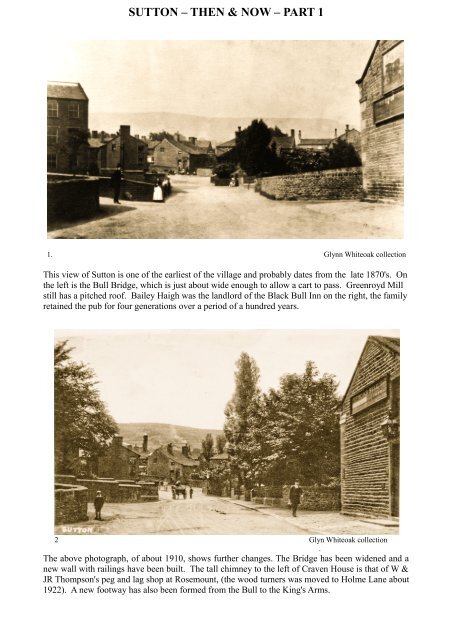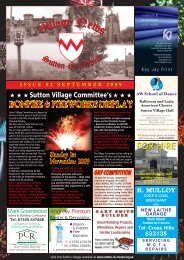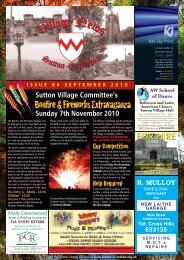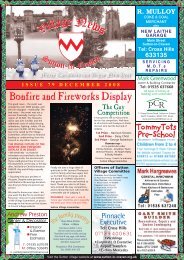then & now â part 1 - Sutton-in-Craven Village Website
then & now â part 1 - Sutton-in-Craven Village Website
then & now â part 1 - Sutton-in-Craven Village Website
Create successful ePaper yourself
Turn your PDF publications into a flip-book with our unique Google optimized e-Paper software.
SUTTON – THEN & NOW – PART 11. Glynn Whiteoak collectionThis view of <strong>Sutton</strong> is one of the earliest of the village and probably dates from the late 1870's. Onthe left is the Bull Bridge, which is just about wide enough to allow a cart to pass. Greenroyd Millstill has a pitched roof. Bailey Haigh was the landlord of the Black Bull Inn on the right, the familyreta<strong>in</strong>ed the pub for four generations over a period of a hundred years.2 Glyn Whiteoak collection.The above photograph, of about 1910, shows further changes. The Bridge has been widened and anew wall with rail<strong>in</strong>gs have been built. The tall chimney to the left of <strong>Craven</strong> House is that of W &JR Thompson's peg and lag shop at Rosemount, (the wood turners was moved to Holme Lane about1922). A new footway has also been formed from the Bull to the K<strong>in</strong>g's Arms.
3. R. Longbottom collectionThis photograph was taken <strong>in</strong> the 1930's, Thompson's chimney has gone and a garage (beh<strong>in</strong>d thecar) has been built at Rose Cottage (<strong>now</strong> Alister House) for Jimmy Laycock's motor car. It had thebenefit of gas light<strong>in</strong>g, a pit for a mechanic and it's own boiler house and central heat<strong>in</strong>g. The signon the K<strong>in</strong>g's Arms wall advertises Bentley's Yorkshire Breweries Ltd Pure Ales.Dur<strong>in</strong>g the 20 th century the Bull Bridge was widened so much that it is <strong>now</strong> hardly recognisable as abridge. An additional storey was been added to Greenroyd Mill, a house built at Rose Mount (rightof <strong>Craven</strong> House centre) and a new house at the corner of Ash Grove. Street lamps, road signs,street names, road mark<strong>in</strong>gs and telephone wires are small but visible changes.
4.Glynn Whiteoak collectionLook<strong>in</strong>g from <strong>Craven</strong> House with the K<strong>in</strong>g's Arms Inn on the left and the Black Bull Inn at thecentre. The cart shed opposite the Bull was pulled down to widen the bridge and rebuilt on the lowside of the <strong>in</strong>n. The K<strong>in</strong>g's Arms was built <strong>in</strong> the 1850's by William Longbottom, who relocated itfrom K<strong>in</strong>g's Court. The old Manor House was two cottages, the top one was <strong>in</strong>corporated <strong>in</strong>to theK<strong>in</strong>g's Arms <strong>in</strong> the early 1900's. The photograph is possibly taken at the same time as picture 1.The scene today has changed little with the exception that the Bull Bridge and beck are no longervisible and push<strong>in</strong>g a child <strong>in</strong> a pram up the middle of the High Street is <strong>now</strong> a th<strong>in</strong>g of the past.
6. Leonard Davy collectionGreenroyd Mill from Rose Mount. In 1834 John Hartley bought a 112 sp<strong>in</strong>dle sp<strong>in</strong>n<strong>in</strong>g frame fromWilliam Longbottom, <strong>Sutton</strong> mach<strong>in</strong>e maker and <strong>in</strong>nkeeper, at a cost of £92 - 8 shill<strong>in</strong>gs, when themach<strong>in</strong>e was <strong>in</strong>stalled he supplied 5 gallons of ale to celebrate 'foot<strong>in</strong>g the frame'. In 1935 the millwas runn<strong>in</strong>g 12,400 sp<strong>in</strong>dles and 7 comb<strong>in</strong>g mach<strong>in</strong>es and produc<strong>in</strong>g hosiery and knitt<strong>in</strong>g yarns.The Mill has <strong>now</strong> been stone cleaned and extra w<strong>in</strong>dows <strong>in</strong>troduced to give light <strong>in</strong>to the new flats.
7.Glyn Whiteoak CollectionA view up the High Street (orig<strong>in</strong>ally Towngate). The corner shop shown on the left was a grocers<strong>in</strong> the 1950's and 60's and run by Ivan Spence of Steeton. In 1960 there were five shops on the leftof the street, Spence's grocers, Tim Pighill's butchers, Mr Seymour's bakers shop, Mrs Stirk'shaberdashery and Gladys Ingham's sweet shop and store, whilst on the right at the very top, with thetw<strong>in</strong> gables, was the Co-operative store.The corner shop closed it's doors <strong>in</strong> the 1990's and today there are no shops left <strong>in</strong> the High Street .
8. Leonard Davy collectionLister Hill off the High Street. Pr<strong>in</strong>ce Ratcliffe, a well k<strong>now</strong>n <strong>Sutton</strong> character, lived <strong>in</strong>the first cottage on the left, he wore clogs all his life a<strong>part</strong> from dur<strong>in</strong>g his servicedur<strong>in</strong>g the Great War. The telegraph pole was one of many <strong>in</strong> the village, but privatetelephones were still uncommon <strong>in</strong> the 1960's and many households had to share a l<strong>in</strong>e,mak<strong>in</strong>g a private call almost impossible.The two cottages are <strong>now</strong> one house and the multiple telephone wires have gone.
10.Glyn Whiteoak collectionThis group of boys <strong>in</strong> the High Street have been play<strong>in</strong>g with their hoops and guiders and havepaused to pose for the photographer. By the 1950's hoops and guiders were a th<strong>in</strong>g of the past butyou could still buy a whip and top from Mrs Stirk's haberdashery <strong>in</strong> High Street, chalk it up andwhip it along the pavement. The enlargement below shows the hoops a little more clearly.
11.Glyn Whiteoak CollectionHigh Street, <strong>Sutton</strong>. On the right of centre is a street vendor's waggon and horse. Into the 1960's<strong>Sutton</strong> had a number of 'mobile shops'. Raymond Ridsdale from Low Fold and Fred Morrell fromHarper Square had vans and sold fruit and vegetables around the district. Ronnie Holmes cameonce a week from Steeton with his butcher's van and as did Hoyle's 'pop' waggon from Keighley. Inthe 1970's a fish van brought fresh fish from Fleetwood.Motor cars are <strong>now</strong> the central feature of the High Street and the street vendors are long gone.
12. Leonard Davy collectionAbout 1832 William Longbottom opened the K<strong>in</strong>g's Arms Inn at the house <strong>in</strong> the centre of thephotograph. Beer was brewed <strong>in</strong> a small stone brew house, that still stands at the rear. The <strong>in</strong>nrema<strong>in</strong>ed here until he purchased the cottages and croft on the corner of High Street and NorthRoad <strong>in</strong> 1854 and built the present pub.The scene today rema<strong>in</strong>s very much unchanged a<strong>part</strong> from the cottages to the right of the garageroof which have been demolished.
13. Glyn Whiteoak CollectionThe two old cottages centre and right dated back to the 17 th century and stood<strong>in</strong> K<strong>in</strong>g's Court until the late 1960's when they were demolished.Today only the shadow on the gable rema<strong>in</strong>s of the cottages and there is no signat all of the 'privvies' that once stood <strong>in</strong> the foreground.
14.Glyn Whiteoak CollectionThe top o't town, k<strong>now</strong>n as Towngate, as it appeared before John Willie Hartley demolished thecottages to improve the entrance to <strong>Sutton</strong> Hall. The gas lamp was k<strong>now</strong>n as 'Owd Jumbo' and wasalso dest<strong>in</strong>ed for removal and was replaced with a grand three armed column with lamps and watera founta<strong>in</strong>, which <strong>in</strong> turn was also removed.The dormer bungalow at Towngate was built by Fred Morrell <strong>in</strong> the early 1930's
15. Andrew Monkhouse CollectionLook<strong>in</strong>g across Fall Bridge to the Bay Horse Inn and farm. The two build<strong>in</strong>gs between the copperbeech tree and the <strong>in</strong>n were once occupied as a butchers shop and a fish and chip shop. Thebutchers shop was run by Willie Riley and the fish and chip shop by David Coleman. On the rightof the photograph is the water founta<strong>in</strong> and lamp standard which replaced 'Owd Jumbo'.Willie Riley's butchers shop has gone and David Coleman relocated his fish and chip shop to theK<strong>in</strong>g's Arms yard, where it rema<strong>in</strong>ed for many years until it too f<strong>in</strong>ally closed down. The modernlamp column and 'dayglow' road sign are a poor substitute for the f<strong>in</strong>e Victorian water founta<strong>in</strong>which was broken up just after the end of the Second World War.
17.Glyn Whiteoak collectionThis group of properties was once k<strong>now</strong>n as The Fold. The f<strong>in</strong>e Georgian house on the left hadbeen the home of Richard Walters Harper, whose family gave their name to Harper Square. TheBaptist Church once met here and <strong>in</strong> the 1840's William Fawcett, M<strong>in</strong>ister of the Gospel, resided atthe property. In 1891 the house was the occupied by Thomas Parker, a retired police constable, andthis may well be him stand<strong>in</strong>g <strong>in</strong> the gateway <strong>in</strong> his smok<strong>in</strong>g cap.Richard Walters Harper's house was converted <strong>in</strong>to three dwell<strong>in</strong>gs by John Willie Hartley about1900 and only the ground floor w<strong>in</strong>dows are <strong>now</strong> recognisable. The other dwell<strong>in</strong>gs weredemolished at the same time.
18. R. Longbottom collectionThis property, together with a nearby row of four dwell<strong>in</strong>gs and the properties on Overburn Road,were k<strong>now</strong>n as New Market. The house and build<strong>in</strong>gs stood just to the rear of the left hand lodgeat Hall Drive. The lane between the field wall and the build<strong>in</strong>gs lead up to <strong>Sutton</strong> House.This house <strong>in</strong> Hall Drive, although not quite on the footpr<strong>in</strong>t of the property <strong>in</strong> the top photograph,follows an almost identical layout and relationship to it.
20.Glyn Whiteoak collectionA view of <strong>Sutton</strong> House about 1890. A two storey build<strong>in</strong>g with an upper 'tak<strong>in</strong>g <strong>in</strong> door' is justvisible through the trees, this structure spanned the beck and was demolished by John WillieHartley, leav<strong>in</strong>g the base to form a bridge so that the house could be accessed from Ellers Road. Onthe left is the barn and stable block to the house.The field is <strong>now</strong> built over by the Hall Estate and only the roof top of <strong>Sutton</strong> House can <strong>now</strong> beseen between the two houses.
21. R Longbottom collectionThe ma<strong>in</strong> entrance to the <strong>Sutton</strong> Hall Estate. The four cottages of New Market stood somewhereforward of the lodge on the left. The wrought iron gates were made by Wilson Davy, the father ofLeonard Davy who photographed the village <strong>in</strong> the 1950's and 60's.The wrought iron gates were removed dur<strong>in</strong>g World War II, but were saved from the melt<strong>in</strong>g pot bya Keighley dealer called Harry Bairstow who later sold them to Keighley Corporation. They are<strong>now</strong> on the Skipton Road entrance to Cliffe Castle park and house <strong>in</strong> Keighley.
22.Glyn Whiteoak collection<strong>Sutton</strong> Hall was built by John Willie Hartley, worsted sp<strong>in</strong>ner of Greenroyd Mill, <strong>Sutton</strong>. Thehouse was only occupied for a short period and never fully completed <strong>in</strong>ternally. Dur<strong>in</strong>g World WarII it was used as flats and <strong>then</strong> demolished. The cellars were open to the sky <strong>in</strong>to the 1960's andbecame a favoured playground for local children.Noth<strong>in</strong>g <strong>now</strong> rema<strong>in</strong>s of the Hall and it's estate with the exception of the lodge pictured here <strong>in</strong>West Lane, the archway and lodges <strong>in</strong> Hall Drive and the stable block <strong>in</strong> the Clough.
23. Glyn Whiteoak collectionLook<strong>in</strong>g towards the bottom of West Lane. Orig<strong>in</strong>ally k<strong>now</strong>n as Smithy Lane the current name issometh<strong>in</strong>g as a misnomer as it actually runs southwards and did not turn west until it was beyondBankfoot Farm. In the 1950's the barn, with the cart <strong>in</strong> front of it, was occupied by Dennis andEdgar Marklew, who supplied firewood.The scene at the bottom of West Lane rema<strong>in</strong>s much the same today, with the exception of the lowercottages on the right, which fell victim to John Willie Hartley's village improvement scheme.
24.Glyn Whiteoak collectionCottages at the bottom of West Lane. The cottage on the left was occupied <strong>in</strong> the 1930's and 40's by'Owd Zeke', otherwise Ezekiel Sunderland,. He slept <strong>in</strong> the downstairs room <strong>in</strong> a 'cupboard bed',these beds were completely enclosed and entered through a door or doors. They were oncecommon place throughout the district. Zeke is said to have had a hook and pulley device so hecould hoist his table off the floor to prevent the mice gett<strong>in</strong>g at the food he left out.The cottages at the bottom of West Lane <strong>now</strong> pa<strong>in</strong>ted brilliant white are otherwise unchanged.
25. Glyn Whiteoak CollectionDow Well at the bottom of the Ellers. Eller or owler is the dialect word for the alder tree, the woodwas used to make clog soles. Houses had no ma<strong>in</strong>s water supply so those at the top of the villagedrew their water from the founta<strong>in</strong> at Towngate or from Dow Well. The water <strong>in</strong> the well becamecontam<strong>in</strong>ated <strong>in</strong> the early 1960's and was concreted over. It was re-opened <strong>in</strong> the 1980's.Dow Well today, look<strong>in</strong>g somewhat uncared for and and almost engulfed <strong>in</strong> road chipp<strong>in</strong>gs.
26.Leonard Davy collectionThis three storey build<strong>in</strong>g <strong>in</strong> Ellers was k<strong>now</strong>n as the Dolph<strong>in</strong> 'Oyle and the whole top floor wasonce Billy Walton's weav<strong>in</strong>g shop, the tak<strong>in</strong>g <strong>in</strong> door can be seen blocked up on the right. Ellerswas a hotbed of unrest <strong>in</strong> the village dur<strong>in</strong>g the Chartist movement of the 1840's, when disaffectedvillagers were drilled by an 'old soldier' <strong>in</strong> anticipation of a revolution that never materialised.The old Dolph<strong>in</strong> 'Oyle is <strong>now</strong> two dwell<strong>in</strong>gs and today enjoys more peaceable times.
27. Leonard Davy collectionWillie Riley at his pigeon loft <strong>in</strong> Cryer Row, Ellers. A butcher by trade he had a shop on FallBridge and <strong>in</strong> later life made and gave away w<strong>in</strong>dmills, with little articulated men 'driv<strong>in</strong>g' a crankaround. Most gardens at the top end of the village had one, which would, “Go like the clappers,” toquote Willie. He <strong>in</strong>spected them all regularly to make sure they were kept <strong>in</strong> good order.Today the pigeon lofts have given way to a garden, but sadly without the benefit of a w<strong>in</strong>dmill.Ack<strong>now</strong>ledgements: Rachel Simpson & Richard Whiteoak for use of the Glyn Whiteoakcollection, Ken Davy & Keith K<strong>in</strong>g for the Leonard Davy collection and Andrew Monkhouse.









